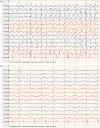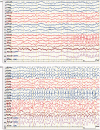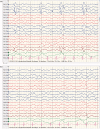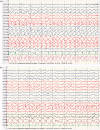Clinical presentation, epidemiology, neurophysiological findings, treatment and outcome of nonconvulsive status epilepticus: a 3-year prospective, hospital-based study
- PMID: 29201532
- PMCID: PMC5700530
- DOI: 10.1080/21556660.2017.1396992
Clinical presentation, epidemiology, neurophysiological findings, treatment and outcome of nonconvulsive status epilepticus: a 3-year prospective, hospital-based study
Abstract
Objective: This study reports the prevalence of Nonconvulsive Status Epilepticus (NCSE) in patients with altered mental status (AMS), and describes the clinical presentation, etiology, neurophysiological findings, neuroimaging, treatment, and outcome of NCSE in Qatar. Recording duration of continuous EEG monitoring was also discussed. Methods: This was a 3-year, prospective, hospital-based study involving patients with AMS and continuous EEG monitoring admitted to the Emergency and ICUs of Hamad Hospital, Qatar. Patients with confirmed diagnosis of NCSE were compared to the patients who did not show EEG and clinical features compatible with NCSE. Descriptive statistics in terms of mean with standard deviation, as well as frequency and percentages for categorical variables, were calculated; Student's t test as well as Chi-square tests or Fisher's exact tests were applied. Logistic regressions NSCE was performed using significance level 0.05 for independent variables at univariate analysis. Results: Number of patients with AMS and continuous EEG monitoring was 250. Number of patients with EEG compatible with NCSE: 65 (age range, 12-79 ys; m, 37; f, 28). Number of controls (defined as patients with EEG not compatible with NCSE): 185 (age range, 12-80 ys; m, 101; f, 84). Rate of occurrence of NCSE in patients with AMS: 26%. NCSE group was younger than controls (p < .001). Twenty patients with NCSE (31%) and 35 patients in the control group (19%) died. Death was more frequent in comatose NCSE compared to controls (p < .0007). NCSE proper and comatose NCSE had longer hospital stays than controls (p < .02 and p < .03, respectively). Complete recovery occurred in 26 NCSE patients (40%) and in 98 controls (53%) (p < .08). Twenty-one patients (31%) presented with refractory NCSE: 12 patients survived, 9 died. Conclusion: This was the first prospective study reporting a high number of NCSE in Qatar, a small country in the MENA region. This prevalence (26%) was in the middle range. NCSE patients did not perform better than controls, outcome being worse with comatose NCSE. NCSE is an emergent condition warranting expedited diagnosis and management. Three days of continuous EEG monitoring were able to diagnose most cases of NCSE.
Keywords: NCSE; cEEG monitoring; epidemiology; outcome; treatment.
Figures








Similar articles
-
Diagnostic Reliability of Headset-Type Continuous Video EEG Monitoring for Detection of ICU Patterns and NCSE in Patients with Altered Mental Status with Unknown Etiology.Neurocrit Care. 2020 Feb;32(1):217-225. doi: 10.1007/s12028-019-00863-9. Neurocrit Care. 2020. PMID: 31617115
-
A study on the clinical and electrographic profile of Nonconvulsive Status Epilepticus (NCSE) in comatose ICU patients using portable electroencephalography (EEG).Med J Armed Forces India. 2023 May-Jun;79(3):292-299. doi: 10.1016/j.mjafi.2021.06.027. Epub 2021 Sep 7. Med J Armed Forces India. 2023. PMID: 37193513 Free PMC article.
-
EEG patterns compatible with nonconvulsive status epilepticus are common in elderly patients with delirium: a prospective study with continuous EEG monitoring.Epilepsy Behav. 2014 Jul;36:18-21. doi: 10.1016/j.yebeh.2014.04.012. Epub 2014 May 16. Epilepsy Behav. 2014. PMID: 24836528
-
Continuous EEG monitoring in ICU.J Intensive Care. 2018 Jul 17;6:39. doi: 10.1186/s40560-018-0310-z. eCollection 2018. J Intensive Care. 2018. PMID: 30026951 Free PMC article. Review.
-
Nonconvulsive status epilepticus and coma.Epilepsia. 2010 Feb;51(2):177-90. doi: 10.1111/j.1528-1167.2009.02297.x. Epub 2009 Sep 10. Epilepsia. 2010. PMID: 19744116 Review.
Cited by
-
Etiology and Mortality of Nonconvulsive Status Epilepticus.Neurol Int. 2025 Feb 17;17(2):29. doi: 10.3390/neurolint17020029. Neurol Int. 2025. PMID: 39997660 Free PMC article.
-
Early and late-onset nonconvulsive status epilepticus after stroke.Arq Neuropsiquiatr. 2021 May;79(5):384-389. doi: 10.1590/0004-282X-ANP-2020-0018. Arq Neuropsiquiatr. 2021. PMID: 34161526 Free PMC article.
-
Estimating the period prevalence of non-convulsive status epilepticus among comatose adults at the University Teaching Hospital in Lusaka, Zambia.Epilepsia Open. 2019 Sep 10;4(4):555-562. doi: 10.1002/epi4.12358. eCollection 2019 Dec. Epilepsia Open. 2019. PMID: 31819911 Free PMC article.
-
New-onset non-convulsive status epilepticus in an adult with hemophagocytic lymphohistiocytosis: a case report.Quant Imaging Med Surg. 2020 Jul;10(7):1559-1565. doi: 10.21037/qims-19-360. Quant Imaging Med Surg. 2020. PMID: 32676373 Free PMC article. No abstract available.
-
Duration of therapeutic coma and outcome of refractory status epilepticus.Epilepsia. 2019 May;60(5):921-934. doi: 10.1111/epi.14706. Epub 2019 Apr 7. Epilepsia. 2019. PMID: 30957219 Free PMC article.
References
-
- Kinney MO, Craig JJ, Kaplan PW.. Hidden in plain sight: non-convulsive status epilepticus-recognition and management. Acta Neurol Scand. 2017;136(4):280–292. - PubMed
-
- Kaplan PW. Nonconvulsive status epilepticus in the emergency room. Epilepsia. 1996;37(7):643–650. - PubMed
-
- Rüegg S. Non-convulsive status epilepticus in adults: an overview. Schweiz Arch Neurol Psychiatr. 2008;159:53–83.
-
- Knake S, Rosenow F, Vescovi M, et al. . Incidence of status epilepticus in adults in Germany: a prospective, population-based study. Epilepsia. 2001;42:714–718. - PubMed
-
- Maganti R, Gerber P, Drees C, et al. . Nonconvulsive status epilepticus. Epilepsy Behav. 2008;12:572–586 - PubMed
LinkOut - more resources
Full Text Sources
Other Literature Sources
Research Materials
